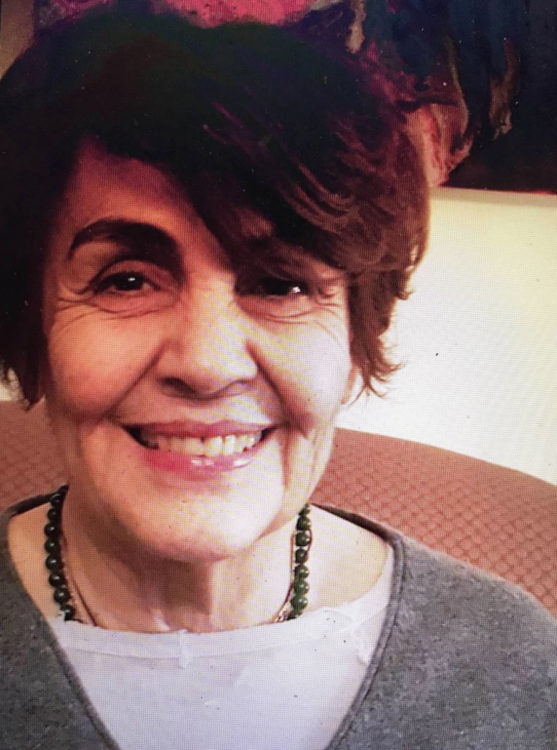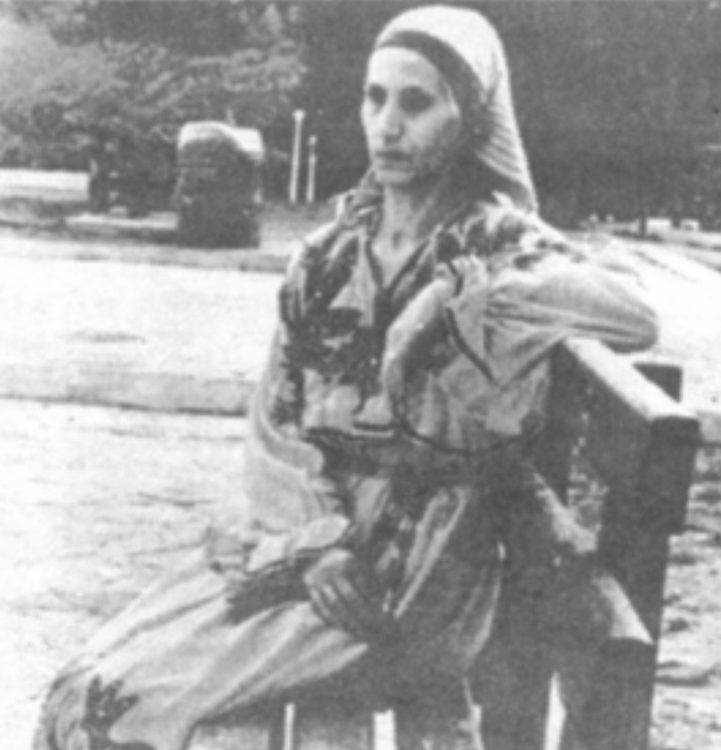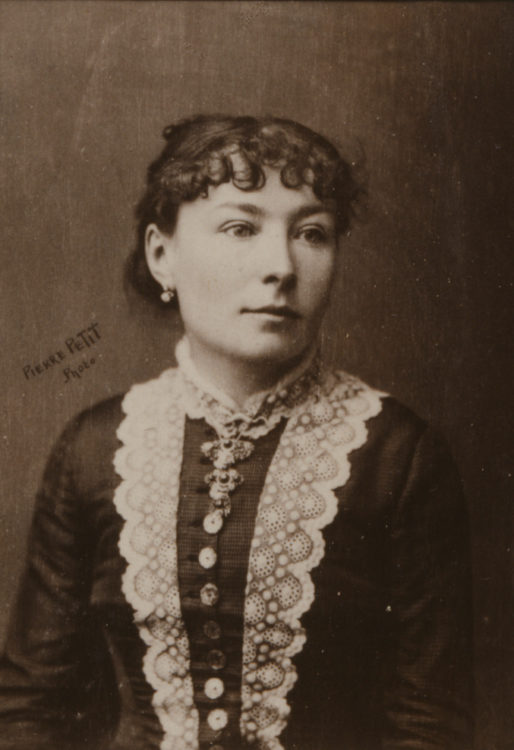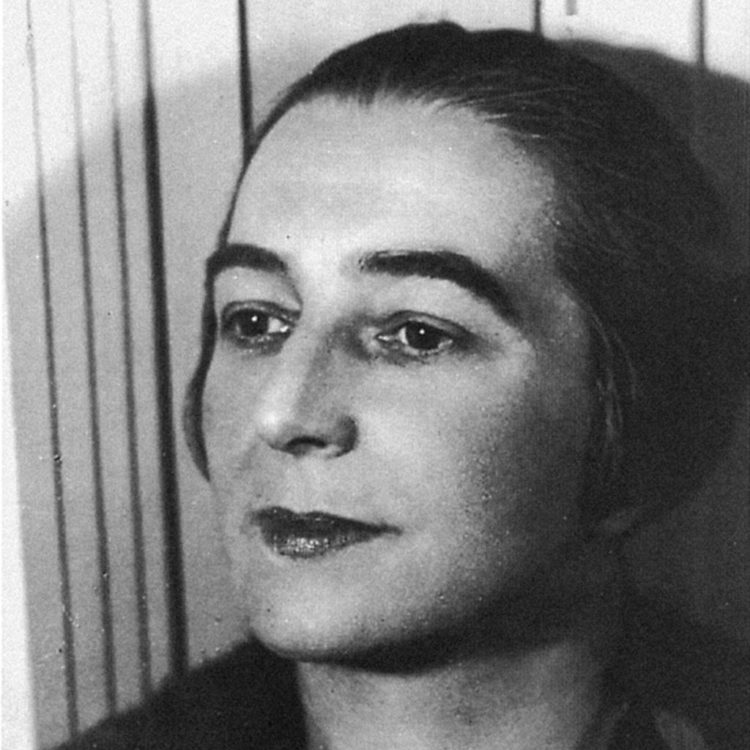Interviews
![<i>La Houle</i> [The Swell]: First Research on the Place of Women Artists in the Collections of the Centre National des Arts Plastiques - AWARE](https://awarewomenartists.com/wp-content/uploads/2019/11/barbara-kruger_who-do-you-think-you-are_1997_aware_women-artists_artistes-femmes.jpg)
Barbara Kruger, Who Do You Think You Are?, 1997, Centre National des Arts Plastiques, © Rights reserved, © Cnap, © Photo: Collection Lambert in Avignon
In 2015 the Centre National des Arts Plastiques (CNAP) implemented a curatorial research grant for curators wishing to develop a project centred on state collections. Liberty Adrien, the 2016 recipient of the grant, recently submitted her research, which focuses on the history of women artists in the collection. On this occasion, Marie Chênel sat down with Juliette Pollet, curator of the visual arts collection since 1991, and Liberty Adrien to talk about the key features of her study and what it highlights in terms of the evolution of mind sets from the 18th century to today.
Marie Chênel: Juliette Pollet, could you tell us how CNAP’s curatorial grant came to be and what its main purposes are?
Juliette Pollet: The grant’s first purpose is to bring attention to CNAP’s extensive collection, which has grown in waves over the years. The collection’s specificity is that it did not follow any precise guidelines, as might be the case with a museum’s acquisitions, but instead developed via sedimentation. Because of this, it is particularly difficult to comprehend in its entirety. The curatorial grant is one of the research strategies that CNAP has devised to create knowledge based on and surrounding this unique body of work. The grant’s second goal is to support the work of independent curators, who are important figures on the contemporary art scene. In doing so it affirms that curators develop outstanding and innovative methods. Other CNAP initiatives focus on supporting academic research, which have led to long-lasting partnerships with, amongst others, Labex Arts H2H, Institut National d’Histoire de l’Art, and École Nationale des Chartes. The call for applications for the fourth session of the curatorial research grant was launched in the summer of 2019.1
![<i>La Houle</i> [The Swell]: First Research on the Place of Women Artists in the Collections of the Centre National des Arts Plastiques - AWARE Artistes femmes / women artists](https://awarewomenartists.com/wp-content/uploads/2019/11/hortense-haudebourt-lescot_le-jeu-de-la-main-chaude_1812_aware_women-artists_artistes-femmes-300x227.jpg)
Hortense Haudebourt-Lescot, Le Jeu de la main chaude, 1812, oil on canvas, 75 x 100 cm, Centre National des Arts Plastiques, © Cnap, © Photo: Yves Chenot
MC: Liberty Adrien, could you tell us about your career? How did your interest in women artists become part of your curatorial practice?
Liberty Adrien: After I graduated from the École Nationale Supérieure des Arts Décoratifs in Paris, I worked for an architecture firm in Copenhagen and Hamburg. In 2015 I had the opportunity to start the independent contemporary art centre Âme Nue. In the course of my explorations of art history and current events in the art world, I found out about the call for applications for the CNAP’s curatorial research grant. I was blown away by the sheer scope of the state collection. At that time, my knowledge of the place of women in arts was somewhat limited, and the prospect of analysing it through the prism of a national collection spanning more than two centuries piqued my interest. I found it surprising that such a study had never been undertaken, and was therefore convinced of the need to do so.
MC: In 2018, in order to present the summary of your Étude sur les œuvres d’artistes femmes acquises pour la collection nationale d’art française [Study of works by women artists acquired for the French national art collection from 1791 to 2017], you compiled a voluminous body of pictures of over 650 works. However, this number only represents 3.8% of the collection’s works by women artists. How did you go about making that specific selection?
LA: First of all, it must be remembered that this national collection is the result of the state’s support policy for artists since 1791. It has grown consistently over time and throughout the various administrations to which it has been attached.
![<i>La Houle</i> [The Swell]: First Research on the Place of Women Artists in the Collections of the Centre National des Arts Plastiques - AWARE Artistes femmes / women artists](https://awarewomenartists.com/wp-content/uploads/2019/11/sonia-delaunay_rythme-couleur-n1076_1939_aware_women-artists_artistes-femmes-300x294.jpg)
Sonia Delaunay, Rythme couleur no 1076, 1939, oil on canvas, 152 x 158 cm, Centre National des Arts Plastiques, © Cnap, © Photo: Yves Chenot
![<i>La Houle</i> [The Swell]: First Research on the Place of Women Artists in the Collections of the Centre National des Arts Plastiques - AWARE Artistes femmes / women artists](https://awarewomenartists.com/wp-content/uploads/2019/11/yayoi-kusama_infinity-mirror-room-firefiles-on-the-water_2000_aware_women-artists_artistes-femmes-300x221.jpg)
Yayoi Kusama, Infinity Mirror Room Firefiles on the Water, 2000, light installation, Centre National des Arts Plastiques, © Cnap, © Photo: Musée des Beaux-Arts de Rouen – Métropole Rouen Normandie
This immense body of 120,000 works by artists of over 400 nationalities reflects the evolution of the French state’s social and cultural policies. Over the course of two centuries it reveals changes in society’s mind set, the influence of worldwide geopolitics, and the effect of industrial and technological mutations on artistic trends. The collection, as a mainstay that has resisted the blind spots of history, gives us rare insight into societal changes, and makes it all the more valuable in our study of the recognition of the place of women in the arts. Therefore, the curatorial research I undertook consisted of an analysis of its evolution as seen through the lens of the acquisition of works by women artists by the state. How many of these works were bought each year? What are the major artistic characteristics of each period? Are there ways of relating these numerical elements and these works to sociopolitical and cultural contexts? What do the remarkable lives of some of these artists look like?
The first stage of my work was to pull data from the collection and analyse it. By doing so, I realised that during the historical period (1791-1904) and the modern era (1905-1959), the proportion of works by women artists purchased amounts to about 10.5% and 13.5%. For the contemporary period (since 1960), the percentage goes up to 17,5%. The state’s acquisition policy, much like the process of women’s emancipation around the world, has never followed a gradual and regular pattern throughout history.
Once these numbers were established, the second stage consisted of scanning and examining thousands of these works; that is, a total of some 17,000 pieces created by women, that is, 14.2% of the collection. These numbers only represent a minimum, in that many of the works are by unknown makers or were archived without gender specifications in the CNAP database.
![<i>La Houle</i> [The Swell]: First Research on the Place of Women Artists in the Collections of the Centre National des Arts Plastiques - AWARE Artistes femmes / women artists](https://awarewomenartists.com/wp-content/uploads/2019/11/baya_sans-titre_1964_aware_women-artists_artistes-femmes-300x197.jpg)
Baya, (Sans titre), 1964, gouache on paper, 100 x 150 cm, Centre National des Arts Plastiques, © Othmane Mahieddine, © Cnap
JP: Eighty per cent of the works in the collection are accessible online for anyone to see. Thanks to the curatorial research grant, Liberty Adrien was allowed access to the entire database. While the size of the inventory is truly overwhelming, documentation for some of the pieces remains lacking.
LA: I’d like to circle back to your question about the way I made my selection. To start with, it seemed necessary to me to study works from various fields of the arts indiscriminately, whether they belong to the fields of visual arts, decorative arts, photography or video. I chose a chronological approach and explored name after name on the list of women artists in the collection, following the evolution in styles and subjects, as well as the social contexts in which the works were created. I tried to understand these artist’s situations: what their social condition was, what world they lived in, and what they sought to express.
During this process, I discovered a wealth of unusual personalities, such as the Algerian painter Baya (Fatma Haddad, 1931-1998). Baya was an orphan and had to work from a very young age. The career of this self-taught artist took an unexpected turn when she met the well-known art dealer Aimé Maeght in Algiers. Her bright, unaffected and joyful paintings were exhibited in Paris to great success by the time she was sixteen, at a time when France was still suffering from the aftermath of the Second World War. Her artistic career was brought to a halt for ten years because of the obligations of an arranged marriage, but picked up again in the 1970s. Baya is now recognised as a major figure in Algerian modern art.
![<i>La Houle</i> [The Swell]: First Research on the Place of Women Artists in the Collections of the Centre National des Arts Plastiques - AWARE Artistes femmes / women artists](https://awarewomenartists.com/wp-content/uploads/2019/11/tarsila_a-cuca_vers-fevrier-1924_aware_women-artists_artistes-femmes-300x249.jpg)
Tarsila, A Cuca, 1924, oil on canvas, 60.5 x 72.5 cm, Centre National des Arts Plastiques, © Tarsila do Amaral Licenciamento e Empreendimentos Ltda, © Cnap, © Photo: Yves Chenot
![<i>La Houle</i> [The Swell]: First Research on the Place of Women Artists in the Collections of the Centre National des Arts Plastiques - AWARE Artistes femmes / women artists](https://awarewomenartists.com/wp-content/uploads/2019/11/francoise-demulder_liban_19-janvier-1976_aware_women-artists_artistes-femmes-300x202.jpg)
Françoise Demulder, Liban, 19 janvier 1976, blanck and white photograph, 41.2 x 51 cm, Centre National des Arts Plastiques, © Françoise Demulder, © Agence Roger-Viollet, © Cnap, © Photo: Yves Chenot
The life of the Brazilian painter Tarsila do Amaral (1886-1973) is equally remarkable. As a young mother, she took private painting lessons in São Paulo before moving to Paris to further her training at the Académie Julian. After her stay in the French capital, where she immersed herself in the exuberant atmosphere of the avant-garde, T. do Amaral became a member of the Group of Five (O Grupo dos Cinco), a pioneering modernist movement in Brazil. Her astonishing works were informed by her experiences, her memories of growing up on a farm, her sensitivity regarding the issue of poverty, and her commitment against dictatorship in her country.
The reports of French war photographers Françoise Demulder (1947-2008) and Alexandra Boulat (1962-2007) are also indispensable. Other favourites of mine include the more contemporary approaches of French-Canadian artist Kapwani Kiwanga (b. 1978) and Chilean artist Sandra Vásquez de la Horra (b. 1967).
It was hard for me to cut my summary down to 500 artists. I decided to trust my instinct as a curator and to let myself get carried away by the unusual power of some of these creators who I believe have changed my perspective on art history. This body of research could be called militant, in that I wish to highlight the prolific and exceptional nature of the works of women artists in the collection, and therefore raise the question of a situation that is still relevant to this day: the lack of fair representation of women artists in our museums and historical discourse.
MC: Isn’t this exactly why research such as yours can contribute to rewriting a history that was built on literally invisible parts?
LA: Precisely. The public has the right to know about the full extent of art history, not only the male side of it.
Here’s an eloquent example of this: I visited the Musée d’Art moderne de la Ville de Paris’s permanent collection exhibition in October 2018. Out of the 86 modern art pieces on display, only four – that is, less than 5% – were made by women artists. I decided to look into the works kept in the museum’s storage and visited the online collection. There I found incredible modern paintings by artists such as María Blanchard, Sonia Delaunay, Leonor Fini, Natalia Goncharova, Marie Laurencin, Valentine Prax, Dorothea Tanning, Suzanne Valadon, and Maria Helena Vieira da Silva. In May 2019, when I visited the new exhibition of works from the collection, which was more focused on the contemporary period, about 25% of the works were by women. Should we be satisfied with this?
![<i>La Houle</i> [The Swell]: First Research on the Place of Women Artists in the Collections of the Centre National des Arts Plastiques - AWARE Artistes femmes / women artists](https://awarewomenartists.com/wp-content/uploads/2019/11/rachel-baes_la-premiere-lecon_1951_aware_women-artists_artistes-femmes-247x300.jpg)
Rachel Baes, La Première Leçon, 1951, oil on canvas, 65 x 54 cm, Centre National des Arts Plastiques, © Rights reserved, © Cnap
MC: Of course not! Could you tell us more about the title you gave your research, La Houle [The swell]?
LA: In French, this feminine noun describes both a steady ripple on the surface of the sea, independent from any localised wind, and the undulation of a crowd. In the course of my research on the evolution of women’s rights – a field of knowledge that is vital in the understanding of the lives of the artists in the collection – I frequently came across the word “wave” and “backlash”. From age to age and all over the world, women have wanted to be free citizens with equal rights. La Houle illustrates their strength, their resistance, their independence, and their civic and social victories, as well as the backlash of history, repression and denial of their fate by the dominant classes.
MC: The rates of acquisitions show only a very slow progression, which is why the title of your research seems so appropriate. What were the aspects that surprised you most while you were analysing the data?
LA: When studying the curve of acquisitions of works by women, I was taken aback by how discontinuous its growth was. Its moving average is sinusoidal, irregular, constantly varying. The maximum amplitudes – years during which the proportion of acquisitions of works by women was high – are followed by sharp decreases.
![<i>La Houle</i> [The Swell]: First Research on the Place of Women Artists in the Collections of the Centre National des Arts Plastiques - AWARE Artistes femmes / women artists](https://awarewomenartists.com/wp-content/uploads/2019/11/nil-yalter_la-femme-sans-tete_1975_aware_women-artists_artistes-femmes-300x237.jpg)
Nil Yalter, La Femme sans tête, 1975, video, 24’47’’, Centre National des Arts Plastiques, © Nil Yalter, © Cnap
![<i>La Houle</i> [The Swell]: First Research on the Place of Women Artists in the Collections of the Centre National des Arts Plastiques - AWARE Artistes femmes / women artists](https://awarewomenartists.com/wp-content/uploads/2019/11/lorna-simpson_cloudscape_2004_aware_women-artists_artistes-femmes-300x300.jpg)
Lorna Simpson, Cloudscape, 2004, video, 3’34’’, Centre National des Arts Plastiques, © Rights reserved, © Cnap
Here is a brief exploration of these rates: from the 1830s to the 1860s, the state’s acquisition rate of works by women artists was approximately 16% and relatively stable. The collection features artists who won several prizes, such as Hortense Haudebourt-Lescot (1785-1849), Augusta Lebaron-Desves (1804-?) and Nélie Jacquemart (1841-1912). However, between 1880 and 1895 the average rate then drops to 4.6%, despite the fact that women painters and sculptors are known to have been present at art salons at the time: Virginie Demont-Breton (1859-1935) was awarded a gold medal at the Amsterdam International Colonial and Export Exhibition in 1883; Jeanne Itasse (1865-1941) won prizes at the Chicago (1893) and Paris (1900) world fairs; and Hélène Bertaux (1825-1909) was awarded a gold medal at the 1889 World’s Fair, to cite only three of the artists featured in the collection.
After this, the curve goes up again slowly and reaches an average of about 15% during the 1930s, then falls back to 9.5% under the Vichy regime. A renewed increase to 15.5% can be observed between 1945 and 1960, then again a drop to 11% between 1960 and 1968. The partiality of cultural and social policies was unarguably one of the triggering factors in the militant spirit of young artists who started their career in the 1960s and 1970s, such as Marina Abramović, Eleanor Antin, Jenny Holzer, Lea Lublin, Yoko Ono, ORLAN, Annette Messager, Tania Mouraud, Nicola L., Gina Pane, Martha Rosler, Niki de Saint Phalle, Shigeko Kubota and Nil Yalter.
Between 1968 and 1985, the proportion increased to 18.6% and plummeted again in the 1980s, reaching its all-time low of barely 4.6% in 1988. The political activism of many artists who started their careers during this low point in the 1980s and 1990s is also telling. To name only a few: Martine Aballéa, Ghada Amer, Vanessa Beecroft, Barbara Kruger, Mariko Mori, Chloe Piene, Cindy Sherman, Lorna Simpson, Jana Sterbak, and Rosemarie Trockel.
Since 2000 the proportion of women artists has hit an average of 24%, with a high point of 50% in 2014. The variations in these rates give us clues as to a period’s state of mind. They implicitly point to the influence of policies and society’s views on women’s emancipation. They help us analyse the evolution of the arts and of the Western market at various times. When we look at the lowest periods and see artists who managed to stand out, one realises how strong and immensely talented they had to be in order to overcome the obstacles that were put in their way.
MC: One question comes to mind: Is a new decline still to be feared?
LA: I broach this question in the conclusion of my research. According to my analysis and considering the current evolution of geopolitics, it seems to me that the enactment of a law imposing quotas for an equal representation of genders in cultural institutions that receive public funding would offer some form of protection. The argument against quotas, according to which they would impact the overall quality of the artwork, seems unjustified to me, in that there are already so many great women artists out there.
I would also like to mention my relative surprise at not seeing more African artists or artists from the diaspora in the collection. This lack of representation is unfortunate, especially considering how the histories of France and of the African continent are so tightly interwoven. These women face the double discrimination that endures both in the art world and in our societies.
MC: You have written that the research to be undertaken is endless and that it would be unrealistic to seek to intersect all of the elements at hand. Were you for instance able to access elements that would help compare the ages of the artists at the time their works were acquired? Are there any gender-based disparities when it comes to age?
LA: I didn’t look into the ages of the artists at the time their works were acquired. However, it must be noted that some of the pieces in the collection were bought after the artist died, although most were acquired in the artist’s lifetime.
JP: The latest acquisition committee decided to acquire works by artists from different generations, such as Simone Fattal (b. 1942) and Mimosa Echard (b. 1985), to name only two recent examples.
![<i>La Houle</i> [The Swell]: First Research on the Place of Women Artists in the Collections of the Centre National des Arts Plastiques - AWARE Artistes femmes / women artists](https://awarewomenartists.com/wp-content/uploads/2019/11/louise-bourgeois_seamstressmistressdistressstress_1995_aware_women-artists_artistes-femmes-293x300.jpg)
Louise Bourgeois, Seamstress/Mistress/Distress/Stress, 1995, ink and garters sewn on handkerchief in a wooden box, 3.3 x 33.3 x 33.3 cm, Centre National des Arts Plastiques, © The Easton Foundation, © AADAGP, Paris, © Cnap, © Photo: Yves Chenot
![<i>La Houle</i> [The Swell]: First Research on the Place of Women Artists in the Collections of the Centre National des Arts Plastiques - AWARE Artistes femmes / women artists](https://awarewomenartists.com/wp-content/uploads/2019/11/hito-steyerl_november_2004_2_aware_women-artists_artistes-femmes-300x225.jpg)
Hito Steyerl, November, 2004, video, 25’, Centre National des Arts Plastiques, © ADAGP, Paris, © Cnap, © Photo: Galerie In Situ / Fabienne Leclerc
MC: Liberty, you also chose to broaden your research to include various fields. Did you notice a higher rate of acquisitions of works by women artists in specific fields, such as textile art or photography?
LA: In the collection, 56.3% or so of artists in the field of textile arts are women. In the field of new media, the proportion is about 35%; there are about 25.7% in photography, and 20% in painting. As for sculpture, the rate of women artists drops to barely 15%.
MC: What potential follow-up(s) do you see for La Houle, now that you have presented the summary of your research to the CNAP?
LA: New questions have arisen since: How could this study be further used to ensure that these works are more widely shown to the general public? What curatorial methods could we develop in view of passing on this knowledge?
Today’s digital tools enable us to share information with an extremely wide audience. The first follow-up to my study will be to present a digitalised body of 228 works (the collection celebrated its 228th anniversary this year) in the CNAP’s collection database.
![<i>La Houle</i> [The Swell]: First Research on the Place of Women Artists in the Collections of the Centre National des Arts Plastiques - AWARE Artistes femmes / women artists](https://awarewomenartists.com/wp-content/uploads/2019/11/shirley-jaffe_new-york_2001_aware_women-artists_artistes-femmes-203x300.jpg)
Shirley Jaffe, New York, 2001, oil on canvas, 250 x 170 cm, Centre National des Arts Plastiques, © ADAGP, Paris, © Cnap, © Photo: Galerie Nathalie Obadia
![<i>La Houle</i> [The Swell]: First Research on the Place of Women Artists in the Collections of the Centre National des Arts Plastiques - AWARE Artistes femmes / women artists](https://awarewomenartists.com/wp-content/uploads/2019/11/germaine-richier_coureur_vers-1955_aware_women-artists_artistes-femmes-190x300.jpg)
Germaine Richier, Coureur, ca. 1955, bronze, hight: 192 cm, Centre National des Arts Plastiques, © ADAGP, Paris, © Cnap, © Photo: Fabrice Lindor
JP: Yes, we intend to create a section in the online collection devoted to “228 years of acquisitions of works by women artists”, which will be digitally curated by Liberty Adrien. A database is a great tool, in that it gives you access to a wealth of information. However, the principle is that you only find what you are looking for, and therefore what you already know. This is why creating a platform to showcase these artists, whether very famous or unknown, seems like the right thing to do for all intents and purposes. Furthermore, at the instigation of this research and concurrently with the partnership between the CNAP and the AWARE Prize, we have begun to collaborate with AWARE, setting up cross-references between the association’s growing index of biographical presentations and our own database.
LA: It was difficult, not to say heart-wrenching, to whittle down my summary from a body of 650 to 228 works. I tried to represent the historical, modern, and contemporary periods in equal proportions, and to highlight artists of various nationalities and languages. Just like the invaluable partnership with AWARE, I consider this digital collection, which will be permanently accessible online, to be one of the foundations of what we are trying to build. These initiatives will come hand in hand with the posting of a selection of pieces from the collection on social media, as well as the presentation of my research at roundtables and in universities in France and abroad. I am always on the lookout for new opportunities and new partnerships to highlight these artists and bring them to the attention of a wider audience. For instance, I am currently working with the French Institute in Berlin on an exhibition project for 2020, presenting video pieces by women artists from several French collections, all of which explore our contemporary perceptions of the relationship between humankind and nature.
Find out more at: http://www.cnap.fr/http%3A/%252Fwww.cnap.fr/appel-projet-2019-bourses-de-recherche-curatoriale-du-cnap.
Liberty Adrien is an independent curator and art historian. She founded the Âme Nue arts centre in Hamburg and has works with institutions all over Europe. She currently lives in Berlin.
Marie Chênel is an independent curator and art critic. She is a member of the French branch of the International Association of Arts Critics (AICA France) and is a regular contributor to specialised magazines, monographic publications and exhibition catalogues.
Juliette Pollet is a heritage officer in charge of the contemporary art section at CNAP, in its most far-seeing aspects. She regularly writes texts and curates exhibitions in the fields of art and design. She also teaches at the École Nationale Supérieure de Création Industrielle (ENSCI) and at the Parsons School in Paris.
Liberty Adrien, Juliette Pollet & Marie Chênel, "La Houle [The Swell]: First Research on the Place of Women Artists in the Collections of the Centre National des Arts Plastiques." In Archives of Women Artists, Research and Exhibitions magazine, . URL : https://awarewomenartists.com/en/magazine/la-houle-une-premiere-recherche-sur-la-place-des-femmes-dans-les-collections-du-centre-national-des-arts-plastiques/. Accessed 19 April 2024














